The training of a bonsai begins when it is strong enough and large enough to withstand treatment. With seedlings this is perhaps when the young tree has formed shoots about two inches long. With more mature trees it should not be undertaken until the tree is showing all the signs of good health. The beginning of training is seeing the tree's potential. It is essential to study the tree carefully and decide what size and shape it is to be, bearing in mind its species and natural form. It is very important to decide at the begin-ning which side of the tree is the 'front'.
There are a number of methods of training bonsai including pinching, trimming, pruning, wiring, tying and feeding. The principal methods of maintaining a trained tree in good order are pinching, trimming, leaf trimming and feeding. Pinching and trimming Shape is both created and maintained by pinch-ing and trimming. Some new leaf buds are removed in spring, and to a degree throughout the growing season, to prevent the growth of unwanted shoots. Buds are encouraged to grow where, and to the extent that, new shoots are required. Trimming may be done with scissors or with the fingers. The greatest care must be taken to remove only what is not required. The precise methods of pinching and trimming, which vary from species to species, are illustrated.
 Trees with needle-like foliage, such as spruce or larch (but not pines) should have their shoots pinched back to about a quarter of their length. This is done while the shoots are still tender and before they have fully elongated.
Trees with needle-like foliage, such as spruce or larch (but not pines) should have their shoots pinched back to about a quarter of their length. This is done while the shoots are still tender and before they have fully elongated.  The shoots of trees with cord-like foliage, such as Chinese juniper, can be nipped hard back at almost any time during the growing season. Use the thumb and forefinger, and twist and pull at the same time. The shoot will break cleanly and easily.
The shoots of trees with cord-like foliage, such as Chinese juniper, can be nipped hard back at almost any time during the growing season. Use the thumb and forefinger, and twist and pull at the same time. The shoot will break cleanly and easily. On pines the new shoots, or candles, can be nipped in the same way as above. This must be done as the candles elongate, just as the minute new needles begin to appear.
On pines the new shoots, or candles, can be nipped in the same way as above. This must be done as the candles elongate, just as the minute new needles begin to appear. Deciduous trees respond well to having the terminal buds removed together with the top one or two sets of leaves. Always use sharp scissors.
Deciduous trees respond well to having the terminal buds removed together with the top one or two sets of leaves. Always use sharp scissors.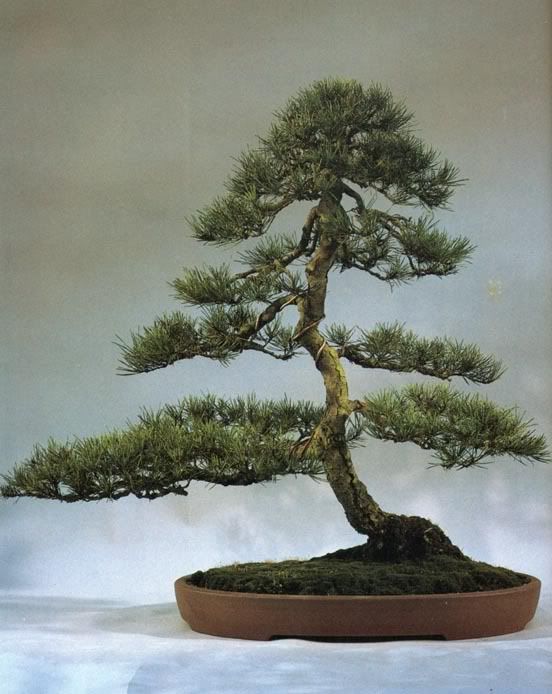
INFORMAL UPRIGHT SCOTS PINE
(Pinus sylvesfris)
This 32 inch tall pine was collected from the wild over ten years ago and is still undergoing training. In spite of this, its beautifully proportioned foliage masses and trunk line make it an extremely desirable tree. Its age is estimated to be 40 years.
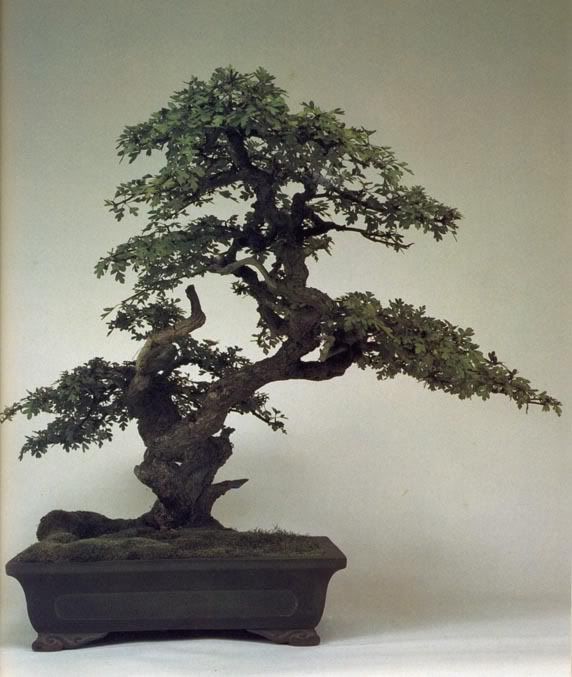
INFORMAL STYLE HAWTHORN
(Cralaegus monogyna)
This 36 inch tall specimen wac rescued from a condemned hedgerow and was carefully nurtured back to health before styling took place. What is now the trunk was originally a hanging branch, the whole tree has been tilted by about 100 degrees to achieve the desired angle. In fact the trunk sweeps dramatically forwards, which prompted its creator, Dan Barton, to name it'Ascending Crane'. It is impossible to estimate its age accurately but it must be well over 70 years old.
Pruning
Once they are mature, pines dislike drastic prun-ing. Most other trees, however, will survive very drastic pruning and dormant buds can be encouraged to break to produce new branches in
the desired place.
Wiring
The best wire to use is copper or aluminium, although plastic-coated iron wire is also suitable.
Wires of different thickness are used according to the size of the branch or trunk. The aim is to
wind a spiral of wire on to the branch so that the wire and the branch can be bent together to the desired shape. However great caution is required and the newcomer to training bonsai would be well advised to practise on unwanted branches first.

Wire should be applied to the branch or trunk sufficiently tightly to be in contact with the bark, but never so tight that it digs in. The illustration on the left shows wire applied at too shallow an angle this could restrict the flow of sap and has little holding power. The centre illustration shows wire applied too loosely, which would have absolutely no holding power at all. The wire on the right has been applied correctly - a 45 degree angle is about right.

Several different thicknesses of wire can be used to hold branches of different weights. Wires on the trunk should be anchored in the soil. Wire on branches should be firmly anchored around another branch or used to shape an adjacent branch. Always run wires parallel to each other, never allow wires to cross since this will create pressure points which will damage the bark.
Tying
It is possible, and very interesting, to train a tree without wiring it. A tie may be attached to a branch which can then be pulled in the desired direction and the other end of the tie fixed to the container or to another suitable anchorage. Alternatively a weight may be suspended from the tie. Ties must not be allowed to cut into the bark and should be removed as soon as the branch has set in its new position.


Various methods of tying can be used to pull the branches into the desired position, however none of them is as accurate as wiring. Of all the methods illustrated, the suspended weight method is probably the least effective.
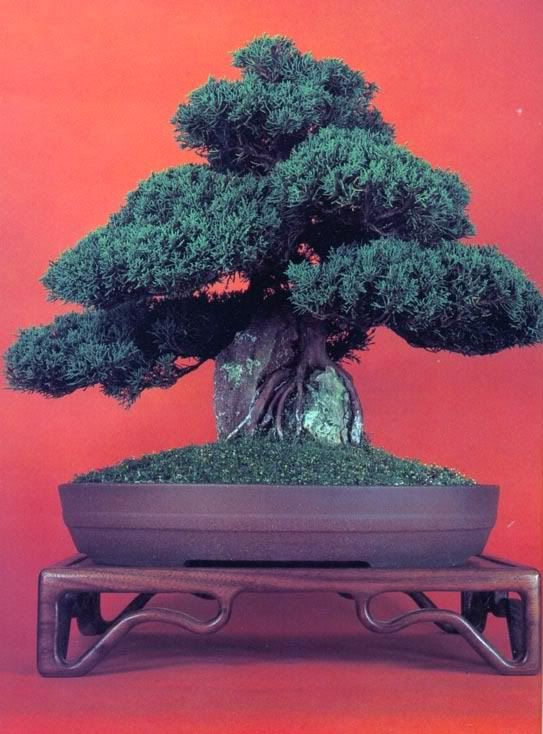
ROOT-OVER-ROCK STYLE BLAAUW'S JUNIPER (Juniperus x media 'Blaauw')
A rooted cutting was planted directly over the rock 16 years ago and left to grow unchecked for eight years n order to establish the root structure. Only then did the training of the branches begin. The height including the rock is now 17 inches.
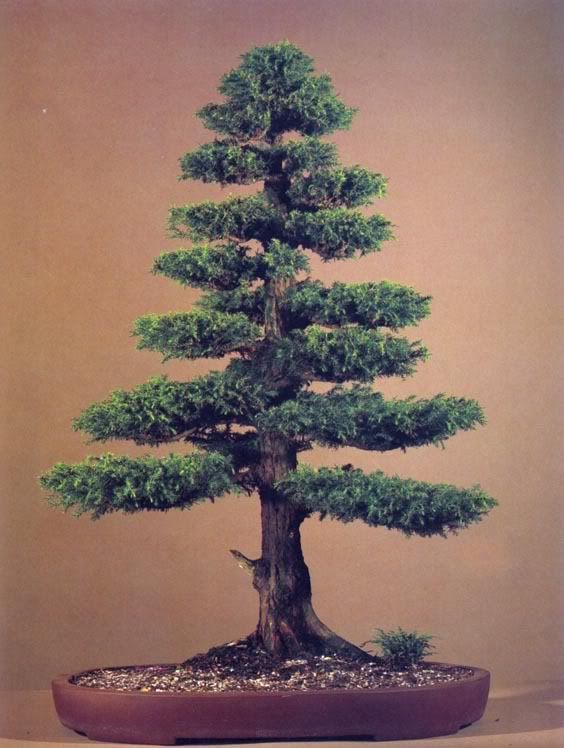
FORMAL UPRIGHT STYLE CRYPTOMERIA
(Cryptomeria japonica)
This classically-styled cryptomeria was estimated to be 50 years old when it was imported in 1976. The well-formed root flare and trunk taper combine with the carefully placed branches to create an almost perfect example of the formal upright style.
Feeding
Successful training and maintenance depend upon having a healthy tree. Both too much and
too little food will have undesirable results. A feeding programme is shown within the work schedule.
Leaf trimming
Certain deciduous trees, notably the maples, benefit when healthy from having all their leaves cut off during late spring or early summer. The new crop of leaves will be smaller and more beautiful. Five-needle pines react to having the still soft new needles pulled out in the spring by producing the following spring very short, bunched needles which enhance the beauty of this type of bonsai. However this should only be done about every three or four years.
Work schedule
The work schedule which follows has been designed for use in both northern and southern hemispheres. As in all gardening the work is sea-sonal and the precise timing of various operations will depend upon the climate, altitude and latitude of the reader's garden and the schedule can be adapted accordingly.
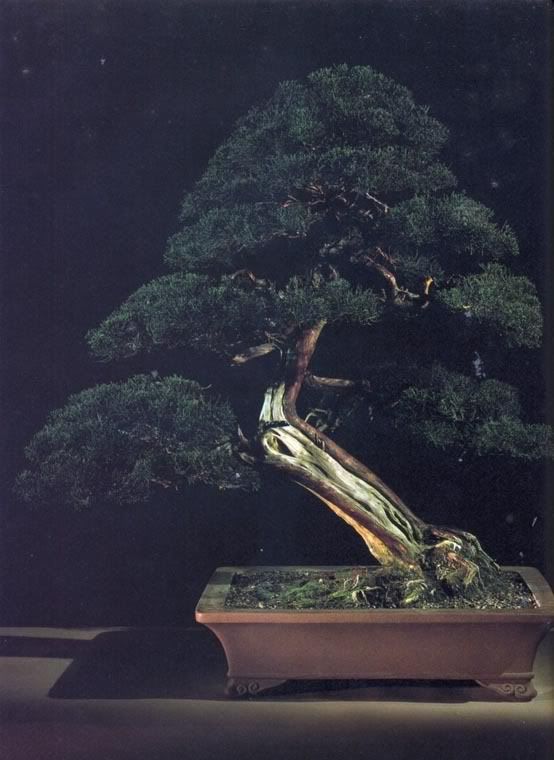
DRIFTWOOD STYLE CHINESE JUNIPER
(Juniperus chinensis)
This massive 35 inch tall specimen was imported from Japan in 1970, and was said to be over 100 years old at the time. It is thought that this tree was formed by splitting the trunk away from its parent tree, which would explain the shari (exposed heartwood) on both front and back of the trunk. The abrupt change in direction of the trunk is perfectly countered by the shape and weight of the
foliage masses.
APPRECIATION
AND JUDGEMENT
For those who have possessed bonsai for a con-siderable time, whether by purchase or by the creation of their own specimens, there is little or no difficulty in seeing at once the good or bad qualities of a tree which they are examining for the first time. A newcomer to the art, however, may not always know what to look for. Locally grown trees are occasionally offered
for sale, but, as a rule, such trees are at best good raw material on which future training may be carried out. If an imported tree is under consideration, other factors come into play.
At the top of the scale there are of course the masterpieces with few, if any, defects. There are
also many imported trees which, while superficially satisfactory, reveal faults on close inspection and which will entail a great deal of work before they can be regarded as really good exam-
ples of bonsai.
This does not mean to say that such lower grade trees are not worth having. The trunk and pot may be good, for example, and the head capable of improvement, but one must be aware
of what one is acquiring or judging. There will probably be many shortcomings to see in any tree in its early stages of development, but at the same time one must not be unduly impressed by the aged appearance of a tree to the exclusion of all other aesthetic considera-tions. It is surprising, in the light of the counsels of perfection offered in expert writings on the subject, how many unhealed wounds or scars from wiring (and even wire left on too long) can
be seen on otherwise reasonably good imported trees. Such blemishes should count against a tree when exhibited in a show, for at such a moment the tricks and scars of training should, ideally, be invisible.Every tree has its best side from which it is meant to be viewed. It is perhaps legitimate, if undesirable, for the unseen side to have certain blemishes; but from the front, branches must appear to spring naturally from the trunk or from larger branches, and must never sprout brush-like from a branch which has been cut straight across without any regard for an appearance of natural development. Presentation and display 'en masse' can cover
a multitude of sins, but a bonsai is intended to stand or fall on its individual merits or demerits. The satisfactory relation of the tree to its pot is of the first importance, and after that comes the set-ting in which the bonsai is placed for exhibition. The following points may be of help to those judging bonsai, as well as to owners wishing to exhibit at shows.
of what one is acquiring or judging. There will probably be many shortcomings to see in any tree in its early stages of development, but at the same time one must not be unduly impressed by the aged appearance of a tree to the exclusion of all other aesthetic considera-tions. It is surprising, in the light of the counsels of perfection offered in expert writings on the subject, how many unhealed wounds or scars from wiring (and even wire left on too long) can
be seen on otherwise reasonably good imported trees. Such blemishes should count against a tree when exhibited in a show, for at such a moment the tricks and scars of training should, ideally, be invisible.Every tree has its best side from which it is meant to be viewed. It is perhaps legitimate, if undesirable, for the unseen side to have certain blemishes; but from the front, branches must appear to spring naturally from the trunk or from larger branches, and must never sprout brush-like from a branch which has been cut straight across without any regard for an appearance of natural development. Presentation and display 'en masse' can cover
a multitude of sins, but a bonsai is intended to stand or fall on its individual merits or demerits. The satisfactory relation of the tree to its pot is of the first importance, and after that comes the set-ting in which the bonsai is placed for exhibition. The following points may be of help to those judging bonsai, as well as to owners wishing to exhibit at shows.
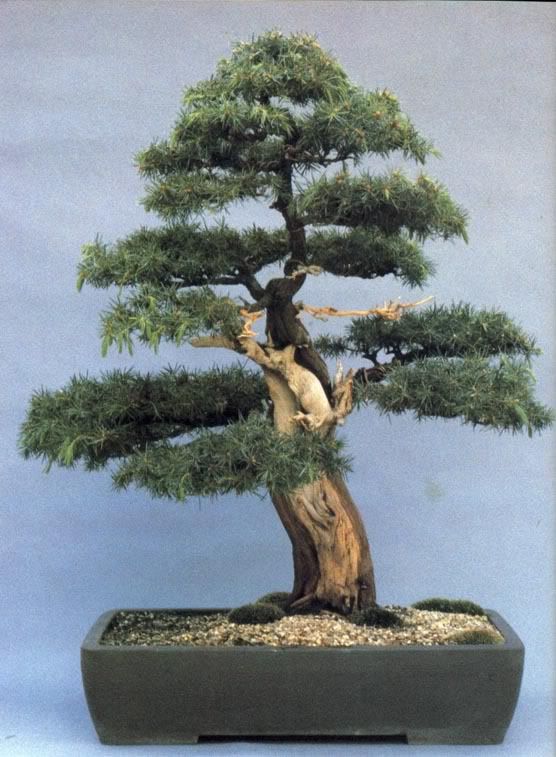
DRIFTWOOD STYLE NEEDLE
JUNIPER
(Juniperus rigida)
Said to be 130 years old when imported in 1974, this magnificent tree shows all the signs of generations of styling and refinement. At 24 inches tall, the well-proportioned crown is in perfect balance with the ancient driftwood trunk.
GOOD
1. A strong, well shaped trunk, tapering upwards, springing naturally from the soil.
2. A good fanning out of surface roots from the base of the trunk, gradually disappearing into the soil.
3. A good, well proportioned head of branches which are well spaced and set naturally on the trunk.
4. The tree as natural looking as possible in the context of the idiom.
5. The pot itself, preferably in monochrome glazes, must be in proportion to the tree, to form an artistic unity. Decorated polychrome pots can of course be used but look wrong when containing flowering or fruiting trees.
6. The tree should be placed in the pot so as to create a visual balance. For example, if the base
of the trunk is towards the right-hand edge, the main weight of the head should incline leftwards. 7. Flowers or fruit, on varieties which are grown to produce these, must be in proportion, forexample a full sized apple would look absurd on a tree one or two feet high.
8. If large leafed trees are used, fewer branches are best, so that the general effect is of an 'impressionist' order, with each leaf giving a broad sweep of green. Pinnate leaves, of course,
give an illusion of a branch bearing small leaves.
9. A tree growing with its roots clasping a rock must really adhere and not merely be wrapped loosely round.
10. A tree should be planted well raised up in its pot, so that the bole can be clearly seen if viewed at eye level over the rim of the pot.
11. Stones and moss or other covering of the surface of the soil must look natural and well established.
12. If deciduous trees are shown in winter, invisi-bility of scars and marks of training is of
paramount importance.
BAD
1. A weak, badly shaped trunk, or one which looks as though it were merely a branch stuck in
the soil.
2. Badly spaced or crossed branches, or those rubbing one on another.
3. Badly cut branches that have in no way callused over.
4. Elaborately artificial effects, often caused by wiring into unnatural curves.
5. Snagged and abruptly cut roots visible above
the soil, or dead fibrous roots standing up in the air.
6. A tree placed exaggeratedly out of balance.
7. Flowers or fruit out of proportion to the size of tree.
8. A pot which is out of harmony with its tree. For example a decorated polychrome pot used for flowering or fruiting species. Plastic pots are aesthetically bad.
9. Foliage which totally hides the trunk, giving the appearance of a bush instead of a tree.
10. A tree planted with the soil and bole sunk far below the rim of its container.
11. Untidy surface of the soil, and fussy, unnecessary decoration such as illshaped, unnatural looking stones.
12. A tree grown in a style totally alien to its species.
the soil, or dead fibrous roots standing up in the air.
6. A tree placed exaggeratedly out of balance.
7. Flowers or fruit out of proportion to the size of tree.
8. A pot which is out of harmony with its tree. For example a decorated polychrome pot used for flowering or fruiting species. Plastic pots are aesthetically bad.
9. Foliage which totally hides the trunk, giving the appearance of a bush instead of a tree.
10. A tree planted with the soil and bole sunk far below the rim of its container.
11. Untidy surface of the soil, and fussy, unnecessary decoration such as illshaped, unnatural looking stones.
12. A tree grown in a style totally alien to its species.
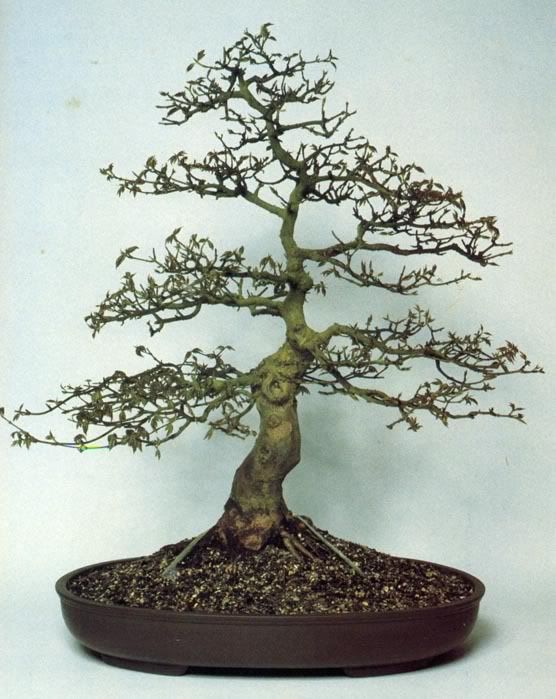
INFORMAL UPRIGHT TRIDENT
MAPLE
(Acer buergerianum)
When it was imported in 1973 this tree was nothing but a stump of a trunk with no branches at all. It was then about 25 years old and 13 inches tall. Over the years, however, new branches and a new leader were grown on until the present design was achieved. The current height of the tree is 30 inches.
MAPLE
(Acer buergerianum)
When it was imported in 1973 this tree was nothing but a stump of a trunk with no branches at all. It was then about 25 years old and 13 inches tall. Over the years, however, new branches and a new leader were grown on until the present design was achieved. The current height of the tree is 30 inches.
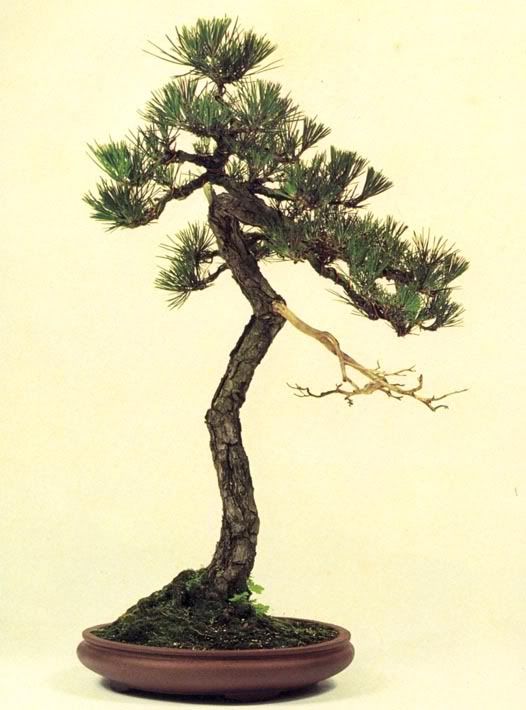
LITERATI STYLE JAPANESE BLACK PINE
(Pinus thunbergii)
When this tree was imported in 1970 it was described as 'a flat topped bush' but its owner soon restyled it by wiring down the branches and creating the jin on the lower right hand side. At 30 inches tall and 38 years old it is now a much improved and highly desirable bonsai.
(Pinus thunbergii)
When this tree was imported in 1970 it was described as 'a flat topped bush' but its owner soon restyled it by wiring down the branches and creating the jin on the lower right hand side. At 30 inches tall and 38 years old it is now a much improved and highly desirable bonsai.




Thank you for all the great information. Something thing that I rarely see is critique on a pictured tree. I saw one article in Bonsai Today, where they had several trees pictured and each one was critiqued good and bad points alike. I know that somethings are perceived differently by each person. However the one article I read was very helpful in teaching me what to look for in my own trees.
ReplyDelete